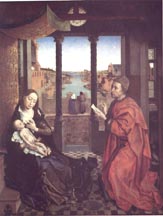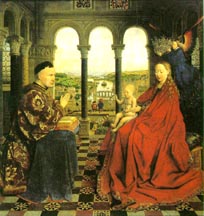

An effective way to introduce a study of Rogier van der Weyden is to compare a version of his painting entitled St. Luke Drawing the Virgin dated after 1435 to the work it is partially based on, van Eyck's Rolin Madonna:


Consider this comparison in relationship to Erwin Panofsky's famous assessment: "...[R]oger's world is at once physically barer and spiritually richer than Jan van Eyck's. Where Jan observed things that no painter had ever observed, Roger felt and expressed emotions and sensations --mostly of a bitter or bittersweet nature-- that no painter had ever recaptured." We have seen that the Virgin has been the focus of many of van Eyck's works. This is true, as we will see, of Rogier as well. But notice the dramatic difference in the conception of the Virgin presented by the two artists.
An issue that needs to be also considered in this comparison is again the social status of the two artists. We have emphasized the importance of the van Eyck's status as a court artist for the Duke of Burgundy. In contrast, Rogier who moved from his native Hainaut to Brussels became in about 1435 "painter to the city." The painting of St. Luke is perhaps the "master" work that Rogier presented to the Guild of St. Luke, the painter's guild. Although not known for certain, it is likely that Rogier's painting was intended for the chapel of the Brussels' painters' guild. Chapels maintained by guilds served both to attend to the spiritual welfare of the members and to be public symbols of the collective pride of the guild. We should understand this painting in relationship to the medieval and early Renaissance idea about the nature of the masterpiece. It is generally accepted that the figure of St. Luke is based on the likeness of Rogier himself rather than the generic, bearded evangelist type as seen in the illumination from the Walters manuscript illustrated below. The dress Rogier shows himself in is identifiable as that of traditional craftsman of the period. Compare it for example with the Goldsmith in the Petrus Christus painting. Instead of showing Luke working on a panel painting as more regularly depicted, Rogier represents St. Luke working on a silverpoint drawing, a precise drawing technique that would need to be mastered by any well-trained painter of the period. Silverpoints were regularly used as prepatory drawings for portaits. This is illustrated by the silverpoint and final painting of Jan Van Eyck's portrait of Cardinal Albergati illustrated below. The Van Eyck's silverpoint shows notations that would have guided him in the completion of the final painting. Rogier's unmistakable borrowing of his composition from Van Eyck's Rolin Madonna situates the work again in the context of the craftsman, who learned his practice of art from copying the work of the best masters. A popular commonplace in medieval intellectual life was characterizing themselves as dwarves sitting on the shoulders of giants, contemporary authority is based on tradition of the masters that preceded. Rogier in this painting situates his work in this tradition of Flemish painting established by Jan Van Eyck. As stated by James Marrow (in Carol Purtle ed., Rogier van der Weyden St. Luke Drawing the Virgin: Selected Essays in Context, p. 57): "Rogier's St. Luke Drawing the Virgin is a seminal document of this kind of pictorial expression. In portraying himself in the guise of an exemplary religious artist, in insisting on the actuality and contemporaneity of the painter's activity, and in referring openly to a work by Jan Van Eyck, all in the context of a guild painting made for his fellow artists, Rogier constructs a visual paradigm of his profession, of his self, and of his place in the tradition to which he belongs. The series of later Netherlandish depictions of St. Luke portraying the Virgin which cite his work and those by Jan Van Eyck, all (or most) of which were likewise made for painters' guilds, confirms the meaning of Rogier's innovative composition and demonstrates the strength and importance of the tradition he initiated in the Lowlands."
Jan Van Eyck, Silverpoint and oil painting Portrait of Cardinal Niccoló Albergati, 1431-32. Artists in the fifteenth century based portraits on silverpoint drawings. Notations on the Van Eyck drawing of what is believed to be Cardinal Albergati include information to guide him in the final painting. |
Walters
281, St. Luke Painting the Virgin, Northern France or Tournai, c.
1430-35. |
||
Detail of the window in Campin's Madonna of the Firescreen. |
|||
Petrus Christus, A Goldsmith in His Shop, 1449. See discussion on page entitled Medieval Guilds and Craft Production. |
|||
Tournai Cathedral, view of the south transept.